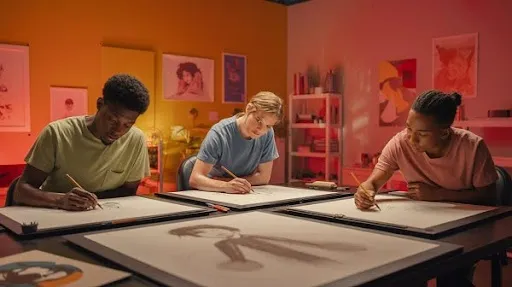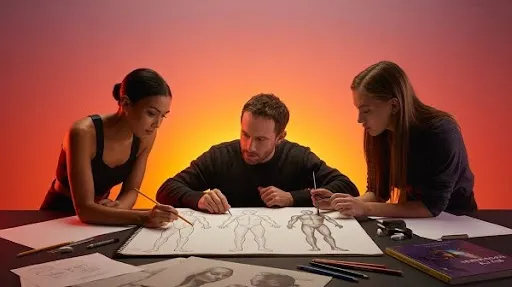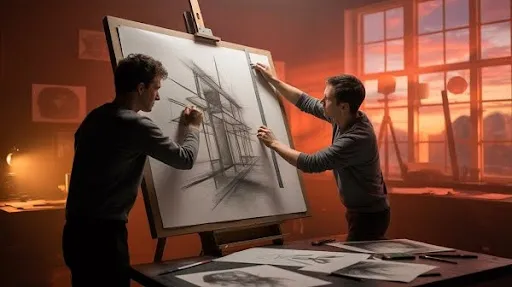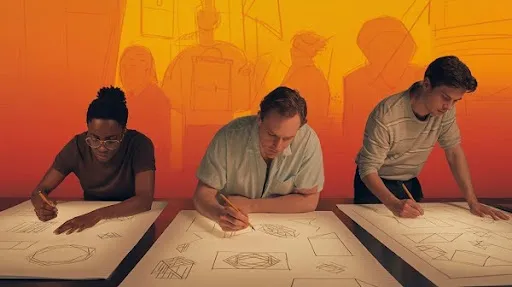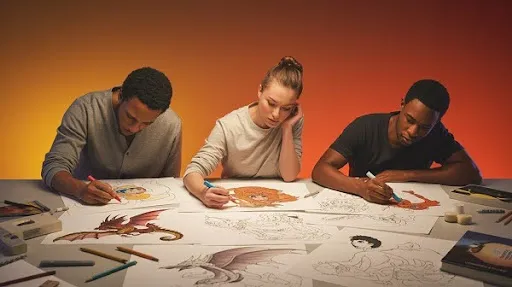Strong art doesn’t just fall onto the page. There’s a backbone under every sketch, painting, or frame of animation, a set of rules that hold it all together. Those rules are the fundamentals of art. They shape how an image looks, how it feels, and how people connect with it.
You’ll notice them in a pencil sketch, a digital painting, or even inside full-blown 3D animation services. These principles aren’t tied to one style or medium. They’re universal.
Ignore them, and your work ends up flat. Learn them, and even something simple, a walking figure or a rough still life, carries weight and movement. That’s the difference between art that feels awkward and art that feels alive.
This guide breaks down the six key fundamentals of art. Each one is essential on its own, but together they give you the toolkit to create work that’s convincing and expressive. By the end, you’ll know exactly what the art fundamentals are and why every artist, from beginner to pro, circles back to them.
What Are the Fundamentals of Art?
At their core, the basic art concepts can be grouped into six areas:
- Anatomy
- Perspective
- Form and Structure
- Lighting and Shadow
- Color
- Composition
Such principles are not arbitrary. They form the basis of design, painting, illustration, and even animation. Flexibility is an inherent characteristic of these principles. They can be adhered to rigidly, stretched to fit one’s style, or even broken completely, but one can never play with standards they don’t comprehend.
Anatomy: Giving Characters Realism
Everything with life has structure. People, animals, plants, each moves in a way that makes sense. Anatomy teaches you that structure, and it’s one of the most vital fundamentals of art and design.
When anatomy is wrong, it jumps out. A leg bends strangely, a pose feels stiff, or a figure looks like it’s about to tip over. When it’s right, the drawing flows. Characters feel solid, and even exaggerated ones keep their believability.
Studying anatomy isn’t about memorizing hundreds of muscles. It’s about seeing how proportions, joints, and weight shift. Once you grasp that, your sketches stop looking static and start looking alive.
Take animation as an example. In 2D, believable poses rely on anatomy. In 3D animation services, models have to bend and stretch like real bodies. If the structure is off, viewers notice instantly.
Anatomy in an Art Fundamentals Class
Figure drawing is usually the first stop in an art fundamentals class. The goal is not to draw a perfect figure, but to understand the principles of rhythm, balance and movement. Characters can be animated to have a semblance of life, as opposed to the default pose, which resembles an inanimate object.
Perspective: Adding Depth to the Page
Perspective is what makes a flat drawing feel like space you can walk into. It’s about distance and proportion, the trick that makes a hallway stretch back or a skyline feel endless.
There are different ways to use the fundamentals of perspective:
- One-point perspective: Lines pull toward a single vanishing point. Think hallways or roads.
- Two-point perspective: Lines vanish toward two different points, great for corners or angled shots.
- Atmospheric perspective: Objects further away fade, lose detail, and shift in color.
From architectural sketches to animated environments, perspective sets the stage. It isn’t just about making drawings look real. It guides the eye and shows viewers where to focus. That’s why it’s one of the six key fundamentals of art.
Form and Structure: From Shapes to Objects
Look around you. A car? Boxes and circles. A tree? A cylinder with clusters of spheres. Even a mug is just a cylinder with a handle.
This is where basic concepts of art come in. Artists reduce complex objects into simple shapes first. Only after the foundation is solid do they add details. It prevents warped proportions and makes complicated scenes easier to manage.
The same principle drives modeling in 3D animation services. A character begins as spheres, cubes, and cylinders before it’s sculpted into something detailed.
Learning Art Fundamentals Through Form
Simple shape exercises help beginners develop an eye for structure. Shade a cube until it feels like a box. Turn a cylinder into a glass or tree trunk. These small drills teach how light and shape work together, laying the groundwork for everything else.
Lighting and Shadow: Giving Work Its Energy
Nothing changes a drawing faster than light. It shapes mood, depth, and form. A smiling face lit brightly feels open. Throw half of it into shadow, and the same face feels tense or secretive.
Mastering light and shadow involves an understanding of light and shadow as physical entities. Lines that are straight, surfaces that are reflective, and gradations of color all obey definite rules. With these, a creator can introduce drama, softness, or even an atmosphere of their choosing.
Painters and illustrators lean on light constantly. For teams handling 3D animation services, lighting is an entire department. Specialists shape how scenes feel, from cinematic spotlights to subtle natural daylight.
Even beginners can learn a lot by placing a lamp beside an apple. Watch how shadows stretch, where highlights fall, and how the roundness becomes clear. That’s the essence of fundamentals of visual arts in action.
Color: Setting the Tone and Mood
Color isn’t filler. It’s the heartbeat of an artwork. Think of a burning red sunset, it doesn’t just glow, it pushes urgency into the scene. Contrast that with a washed-out, gray alleyway. The mood shifts before a single detail is noticed. That’s the weight color carries, and why it earns a place in the six key fundamentals of art.
Every artist, whether painter or animator, relies on color to speak silently. A single adjustment can flip the mood. Warm shades like scarlet, amber, or gold carry fire, energy, even comfort. Cool tones, turquoise, navy, mossy green, breathe quiet and space.
In portraits, skin is never just one “peach.” It’s woven from purples, greens, pinks, and soft shadows. Ignore that, and faces lose their spark.
You’ll see the same in 3D animation services. A cyberpunk skyline glowing in neon violet feels sharp and modern. A woodland scene in earthy greens immediately signals safety and calm. Before any dialogue, the palette already tells you what to feel.
The Basics of Color Theory
Color theory may sound like heavy science, but at its core it’s straightforward. Four ideas shape the fundamentals of visual arts here:
- Hue, the color’s name: blue, red, yellow.
- Value, how light or dark it appears.
- Saturation, its intensity, from soft to screaming bold.
- Temperature, warm reds and yellows versus cool blues and greens.
Simple ideas, big impact. Shift the value of a night sky and you move from romantic dusk to eerie darkness. Drain saturation from a meadow and suddenly it feels lifeless. The smallest change rewires the viewer’s response.
Color in Fundamentals of Art and Design
Designers know color schemes are not arbitrary. Fast food chains make use of red and yellow to provoke hunger and convey a sense of urgency. Wellness and Spa brands use blue and green to create a sense of calm.
In the fundamentals of visual arts, color shapes depth as much as light does. Shadows aren’t pure black, they might hum with violet or cobalt. Highlights aren’t just white; they lean gold, peach, or even pale blue depending on the scene. This attention to nuance keeps work from feeling flat.
Studios offering 3D animation services even assign specialists to color. They’ll test combinations until a cityscape feels alien or a sunset feels nostalgic. Without that layer of intention, even detailed scenes fall dull.
Practicing Color
In an art fundamentals class, the color wheel is often the first assignment. It feels like child’s play at first. Then, while mixing, you realize how easily one hue can overpower another, and suddenly the exercise makes sense.
A common drill is to paint using only three colors. At first, the limit feels suffocating. But soon you discover just how many shades and moods can be squeezed from that trio. The exercise trains your instincts, not just your brush.
Another tip? Pause a film and study its still frame. Notice how a thriller relies on teal shadows with sharp red accents. Compare that to a romantic comedy glowing with pastel yellows and warm light. Filmmakers are master colorists without ever saying so.
Composition: Guiding the Eye
If anatomy and form build structure, composition sets the rhythm. It’s how everything inside the frame connects. It decides what grabs your attention first, where your gaze drifts next, and what emotional aftertaste remains.
Even with brilliant detailing and artwork, weak composition can ruin it. Remarkably, composition can render a sketch of a chair profound. This is why composition remains one of the foremost principles of art and design.
Core Ideas of Composition
A few principles keep layouts from collapsing:
- Rule of Thirds, Split the canvas into thirds. Place subjects on those lines for balance.
- Leading Lines, Roads, rivers, tree branches, all guiding the eye where you want.
- Balance, Spread shapes and tones so one half doesn’t feel heavy.
- Negative Space, The “empty” areas shape the subject just as much as detail.
- Framing, Use elements in the scene to circle or highlight the subject.
These aren’t unbreakable laws. They’re like training wheels. Learn them, then twist them when you want tension or surprise.
Why Composition Matters Everywhere
Step into a gallery and notice: the paintings you can “read” from across the room usually have strong composition.
In illustration, composition tells the story before captions do. In animation, it’s pacing. Camera angles, placement of characters, and scene flow all come from composition choices. For 3D animation services, swapping a wide shot for a close-up can completely change how a moment feels.
Good composition isn’t about decoration. It’s about control. It makes viewers feel exactly what you planned.
Classroom Exercises for Composition
Most art fundamentals classes rely on thumbnail sketches. Dozens of small, rough layouts, no details, just blocks and flow. Through these, patterns emerge. You start seeing why some frames feel balanced while others sag.
Another drill: strip down a master painting into bare shapes. Forget the brushwork, just capture the layout. Suddenly you see the hidden architecture, every figure, tree, or shadow placed with intent.
The Six Fundamentals Working Together
Now the puzzle is complete: anatomy, perspective, form, lighting, color, and composition. None of them stand alone.
Picture flawless anatomy with no composition, the figure feels stiff. Imagine perfect perspective without lighting, the scene sits flat. These fundamentals work like gears. One missing, and the whole mechanism falters.
This is why professional artists, even seasoned animators, return to basics often. They know fundamentals aren’t just lessons for beginners, they’re lifelong practices. Studios that handle 3D animation services rely on them every day, from storyboarding to the final render.
Frequently Asked Questions
What are the art fundamentals?
They’re the six pillars every artist builds on: anatomy, perspective, form and structure, lighting and shadow, color, and composition.
Why should beginners start here?
Because skipping them shows. Without basics, work feels awkward. Practicing fundamentals adds control and flow.
How do fundamentals of perspective appear in animation?
They give depth. In animation, perspective turns flat drawings into worlds viewers believe in.
Is an art fundamentals class necessary?
Helpful, yes. Essential, not always. Books, online tutorials, and consistent practice drills can cover a lot.
What’s the difference between art and design fundamentals versus visual arts fundamentals?
The overlap is big. Visual arts lean toward drawing, painting, animation. Art and design also stretch into branding, layouts, and broader communication.
How do fundamentals connect to 3D animation services?
Everywhere. From modeling to camera angles, lighting to composition, the same basics keep work natural and engaging.
Final Words
Art involves more than simple tips. Master anatomy, perspective, form, lighting, color, and composition. Otherwise, guesswork fills your artwork.
Whether you’re sketching at your desk, experimenting with paint, or working with one of the best animation studios in Austin, like Prolific Studio, offering 3D animation services, these six pillars guide the process. They shape skills, speed, and confidence.
The best advice? Don’t try to learn everything at once. Pick one pillar, focus on it, and fold it into your daily work. Over time, each builds on the other. The difference shows in every line and every frame.
If your goal is growth, this is the foundation. The sooner you take these six key fundamentals of art seriously, the sooner your work stops blending in, and starts standing out.

